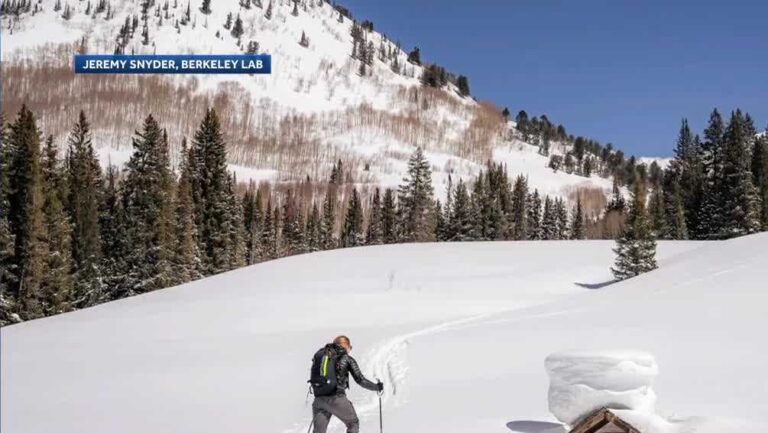Changing weather patterns in California are making it increasingly difficult for scientists to accurately estimate the state’s snowpack. This can be problematic for water managers who rely on accurate numbers to plan spring flood prevention and annual water supply allocations. Historically, a large network of automated sensors called “snow pillows” was used to automatically measure the weight of snow in specific locations. Knowing the weight allows scientists to calculate how much water is in the snow. Combining decades of measurement data with an understanding of past snowfall trends allows scientists to make informed estimates of snowpack in specific areas. As California’s climate changes, the relationships underlying these estimates may become less useful. “When you take all this knowledge from a very long record of the past and try to apply it to new situations that are completely different from the past, that application becomes less reliable as well,” said Marianne Cowherd. Cowherd is currently a doctoral student studying environmental science policy and management at the University of California, Berkeley. As part of her program, Cowherd is working with UC Berkeley’s Central Sierra Snow Lab to find ways to factor climate change into snowpack estimates. “We were very interested in situations where the snowpack itself is decreasing,” Cowherd said. He added that areas at elevations above those snowpacks may also be experiencing snowpack declines, but in some cases, there may be undetected increases. “And if we only use snowpack records and projections based on past events, we may miss things that are happening in areas that we’re not measuring,” Cowherd said. Artificial intelligence could be part of the solution. Cowherd and his colleagues are studying different AI algorithms that can learn from past snowpack data and incorporate climate change models to get a better idea of future snowpack scenarios. “AI is definitely a potential help in solving this problem of wanting to better understand where snow is based on sparse observational data,” Cowherd said, adding that AI should be viewed as a collection of possible tools. The question is finding the best tool for this situation. That will be part of future research, along with better understanding how different water users use snowpack data. California currently uses several methods to get a picture of the snowpack each winter. This includes manual snow surveys conducted monthly. High-resolution satellite imagery and LIDAR measurements are also used, in addition to an automated snow pillow network. Follow KCRA’s weather team on social media: Meteorologist Tamara Berg on Facebook and X. Meteorologist Dirk Verdoorn on Facebook. Meteorologist/climate reporter Heather Waldman on Facebook. Meteorologist Kelly Curran on X. Watch the weather on TV or online. Watch our latest video weather forecasts here. You can also watch a live stream of our latest news shows here. When we’re live, the banner on our website will turn red. We also stream on the Very Local app for Roku, Apple TV and Amazon Fire TV.
Changing weather patterns in California are making it harder for scientists to accurately predict how much snow the state will get, which could pose problems for water managers who rely on accurate numbers to plan spring flood prevention and annual water supply allocations.
Historically, large automated sensor networks called “snow pillows” were used to automatically measure the weight of snow in specific locations. Knowing the weight allows scientists to calculate how much water is in the snow.
Decades of measured data, combined with an understanding of past snowfall trends, allow scientists to make informed estimates of how much snow will fall in a given area. As California’s climate changes, the relationships on which these estimates are based may no longer be valid.
“When you take all of the knowledge we have from a very long record of the past and try to apply it to a new situation that is completely dissimilar to the past, that application is also unreliable,” Marianne Cowherd said.
Cowherd is currently a doctoral student studying Environmental Science Policy and Management at UC Berkeley. As part of her program, she is working with UC Berkeley’s Central Sierra Snow Lab to explore ways to incorporate climate change into snowpack estimates.
“We were really interested in the decline of the snowpack itself. [in snowpack]” Cowherd said.
She added that areas at elevations above these snow pillows may also be experiencing decreases in snowpack, but in some cases may be experiencing undetected increases.
“If we simply use snowpack records and projections based on past events, we may miss things that are happening in areas we’re not measuring,” Cowherd said.
Artificial intelligence could be part of the solution: Cowherd and his colleagues have been working on a range of AI algorithms that can learn from historical snowpack data and incorporate climate change models to better predict future snowpack scenarios.
“AI can definitely help solve this problem of better understanding where the snow is based on just a few observational data,” Cowherd said, adding that AI should be thought of as a set of tools. The question is figuring out which tools are best suited for this situation.
This will be part of future research, along with a better understanding of how different water users rely on snow pillow data.
California currently uses several methods to capture snowpack images each winter, including manual monthly snow surveys, an automated snow pillow network, and high-resolution satellite imagery and LIDAR measurements.
Follow the KCRA weather team on social media
- Meteorologist Tamara Berg’s Facebook page and X.
- Meteorologist Dirk Verdoorn’s Facebook page
- Meteorologist/climate reporter Heather Waldman’s Facebook page and X.
- Meteorologist Kelly Curran X.
Watch the weather forecast on TV or online
You can watch our latest video forecast here, as well as a live stream of our latest news shows here – our website banner will turn red when we’re broadcasting live.
It’s also streaming on the Very Local app for Roku, Apple TV and Amazon Fire TV.


